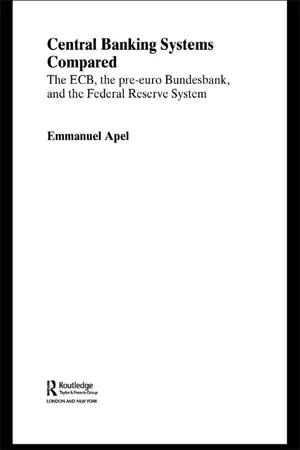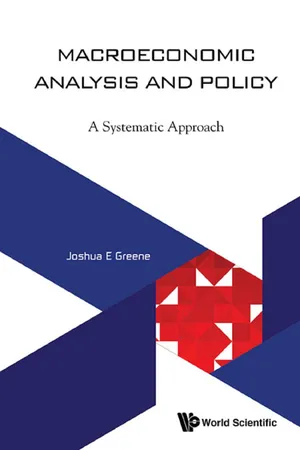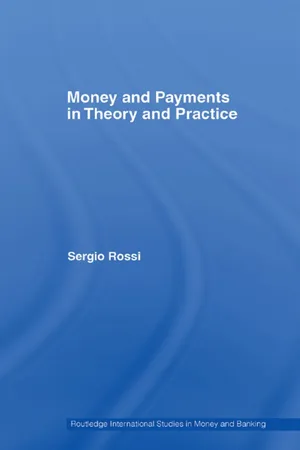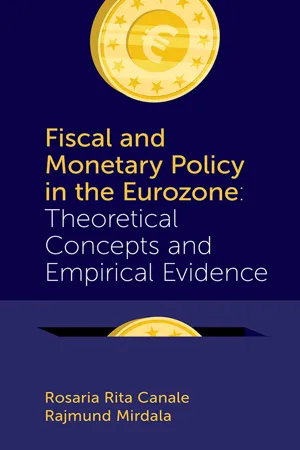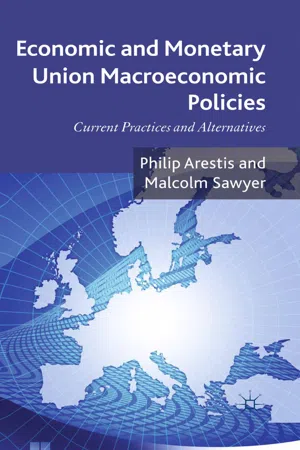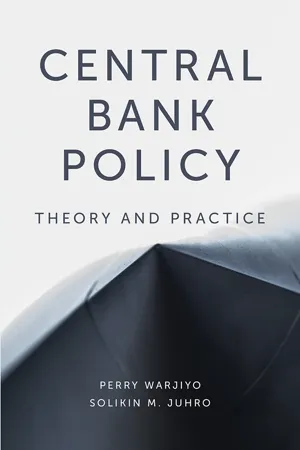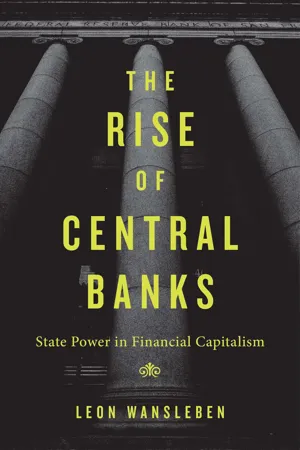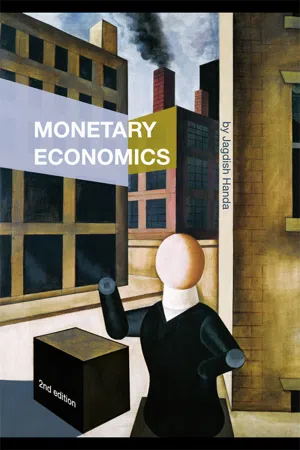Economics
Monetary Policy Strategy
Monetary policy strategy refers to the framework and approach used by central banks to achieve their monetary policy objectives, such as price stability and full employment. It encompasses the tools, rules, and communication methods employed to influence the money supply, interest rates, and overall economic activity. A clear and transparent monetary policy strategy helps guide market expectations and promote economic stability.
Written by Perlego with AI-assistance
Related key terms
12 Key excerpts on "Monetary Policy Strategy"
- eBook - ePub
- Emmanuel Apel(Author)
- 2003(Publication Date)
- Routledge(Publisher)
3 Monetary Policy Strategy, instruments and actions A central bank is assigned an objective, or objectives, to achieve and maintain. To achieve the objective, or objectives, the central bank’s decisionmaking body usually defines a set of procedures to guide its actions. This set of procedures is called the monetary policy strateg y. The pre-euro Bun-desbankused a Monetary Policy Strategy that is called ‘monetary targeting’. Under such a strategy, the central bank chooses a monetary aggregate and determines its monetary policy actions on the basis of comparisons between the target value of the monetary aggregate and the actual value of the monetary aggregate. The target value of the monetary aggregate must be defined so as to be consistent with the central bank’s definition of the ‘price stability’ objective. Another well-known and widely used (Bank of Canada, Bank of England) Monetary Policy Strategy is the ‘inflation targeting’ strategy. Under such a strategy, the central bank’s decision-making body takes monetary policy actions on the basis of a comparison between the target for inflation and the forecast inflation rate. The monetary authority steers the final target variable (the policy objective of ‘price stability’) directly without the use of a separate intermediate target variable, such as the ‘monetary target’. The inflation targeting strategy requires an inflation forecast since monetary policy actions (i.e. changing short-term interest rates) affect the final objective with a lag. The inflation forecast is usually based on a wide range of economic and financial variables to estimate, for example, the future ‘output gap’, which has an impact on price developments - eBook - ePub
Macroeconomic Analysis and Policy
A Systematic Approach
- Joshua E Greene(Author)
- 2017(Publication Date)
- WSPC(Publisher)
Chapter 8MONETARY POLICY
Monetary policy involves the use of certain policy instruments, typically interest rates, to achieve short- and intermediate targets as a way of attaining broader objectives, such as a desired rate of inflation. Figure 8.1 describes the basic framework for monetary policy, regardless of the particular policy regime the monetary authority uses.Beginning in the upper left-hand corner of Figure 8.1 , the monetary authority takes a policy decision and uses instruments to set an operating target — typically a very short-term interest rate, such as that in the overnight money market. The instruments involve activities such as open market operations (buying and selling government securities or its own securities to deposit money banks, sometimes through repurchase (“repo”) or reverse repurchase (“reverse repo”) operations), changing its discount rate, or changing reserve requirements. The monetary authority sets the operating target as a way of attaining an intermediate target — the growth rate of broad money, the exchange rate, or a forecast rate of inflation — in order to achieve an ultimate policy objective, such as a targeted rate of inflation. After attaining its operating target, the monetary authority reviews a broad set of indicator variables, to see how the economy has responded to its actions. Depending on the values of these variables, the authority decides whether to keep policy unchanged or make further changes to its operating target.FIGURE 8.1. BASIC FRAMEWORK FOR MONETARY POLICYI. GENERAL DESCRIPTION OF THE FRAMEWORK FOR MONETARY POLICY
A. The Monetary Policy Objective
Monetary policy can focus on price stability, exchange rate stability, or minimizing the variability in real output - eBook - ePub
- D. Chorafas(Author)
- 2013(Publication Date)
- Palgrave Macmillan(Publisher)
An important role might also be played by unconventional measures in the central bank’s arsenal and their impact on market psychology. Market psychology is as well affected by issues that are, so to speak, unobservable but inferred from a host of secondary variables, anecdotal evidence, rumors, and expectations of the central bank’s future moves. Basic ingredients of a monetary policy are:• Amount of money within a jurisdiction (monetary base as distinct from money supply, section 2),• The definition of bank reserves,• Velocity of circulation of money,• Interest rates,• Exchanges rates,• Inflation or deflation, and more.In general, whatever affects a currency’s stability and public acceptance in the global market comes under the realm of monetary policy, which economists debate as being sound or questionable, firm or ambivalent, clearly stated or uncertain. No monetary policy will find everyone being in accord with its direction and details.The aftermath of a flawed monetary policy extends well beyond economics and into society’s preoccupation with business activity, employment, stability, and improvement in the standard of living. Moreover, the influence of the monetary policy is mitigated by the economic policy and the fiscal policy. In the large majority of cases employment is not one of the objectives in the charter of the central bank. Among major nations the notable exception is the US Federal Reserve whose status was amended by Congress in the late 1960s to target both:• Currency stability, and• EmploymentCurrency stability is possible only if well-done economic policies and spontaneous market forces are geared to maintaining it. If not, what usually takes place is tortuous economic adjustments that, over time, might bring about a sense of stability. More often than not, however, a wrong-way monetary policy sees to it that monetary stability1 is and remains an elusive goal.In contrast to monetary policy, the fiscal policy - eBook - ePub
- Sergio Rossi(Author)
- 2007(Publication Date)
- Routledge(Publisher)
5 Monetary policy strategies
Monetary policy strategies around the world are increasingly centred on attaining some targeted rate of inflation, which several academics and policy makers assimilate to price level stability when the measured inflation rate is around but below 2 per cent (owing to a number of measurement biases, as reviewed by Rossi (2001: 31–41)). As a matter of fact, targeting inflation has become a fashion. Since the Reserve Bank of New Zealand first adopted this Monetary Policy Strategy in 1990, an increasing number of monetary authorities around the world – first in advanced economies only, later also in developing and emerging market economies – have been abandoning their monetary or exchange rate targeting strategy to follow this new fashion. As with several fashions nevertheless, targeting an inflation rate rather than an exchange rate or a growth rate of a monetary aggregate has been adopted without any fully thought-out analytical investigation of a phenomenon as complex and controversial as inflation. The same may be argued with respect to previous monetary policy strategies, as they all stem from a symptom-based perception of inflation.It is indeed both undisputed and undisputable today that ‘[e]conomists’ perceptions of inflation rest on measurements of the “general price level” and on rates of change of price indexes’ (Gale 1981: 2). In fact, as surveys of inflation theories show, neither a satisfactory nor an exact analytical definition of inflation exists as yet in the literature (see Bronfenbrenner and Holzman 1963, Laidler and Parkin 1975, Frisch 1983, Parkin 1987, McCallum 1990). This is so much so that, to date, the phenomenon of inflation has been grasped merely by considering its most evident symptom, namely the increase of the relevant consumer price index (or some core inflation index), with no analytical thought whatsoever as to its underlying cause. - eBook - ePub
Fiscal and Monetary Policy in the Eurozone
Theoretical Concepts and Empirical Evidence
- Rosaria Rita Canale, Rajmund Mirdala(Authors)
- 2019(Publication Date)
- Emerald Publishing Limited(Publisher)
3.3. Evolution of the ECB’s Monetary PolicyThe primary objective of the ECB is to maintain price stability. To achieve this goal, preparatory work on the formulation of the ECB’s monetary strategy was also subordinated. European Monetary Institute (EMI) in the pre-preparation phase to enter the third stage EMU formation (1994–1998) has developed five possible alternatives to monetary strategies:- (1) Monetary strategy to maintain inflation targeting (direct inflation targeting).
- (2) Monetary strategy oriented to the management of money in circulation (monetary targeting).
- (3) A currency strategy aimed at maintaining a fixed exchange rate targeting.
- (4) A monetary strategy aimed at achieving nominal income targeting (GDP).
- (5) A monetary strategy aimed at maintaining interest rates (interest rate pegging).
During the debates, three out of the initially five potential monetary strategies were excluded, and alternatives to the ECB remained a money-stability-oriented strategy and a strategy to maintain a defined inflation rate. When considering these two monetary strategies on the theoretical level, their distinction must be emphasized. However, the practice in countries using an alternative to one strategy has shown that, in fact, the monetary policies thus implemented have many common features. The most significant fact that supports this claim is that both strategies have a common primary objective of maintaining price stability. Both strategies use some of the same monitoring variables. The main factor distinguishing both strategies is the role played by monetary aggregates in individual strategies. However, these strategies have much more common features than those that distinguish them. - eBook - ePub
Economic and Monetary Union Macroeconomic Policies
Current Practices and Alternatives
- P. Arestis, Kenneth A. Loparo(Authors)
- 2013(Publication Date)
- Palgrave Macmillan(Publisher)
Source : ECB (2008, p. 60).Any currency necessarily has a corresponding central bank (or equivalent), which can issue the currency and set one or more key policy interest rates; the latter set the terms under which the central bank interacts with the banking system. The ways in which the central bank set interest rates and relates to the fiscal authorities are crucial to the success or otherwise of a currency. Furthermore, monetary policy faces an inevitable ‘one size fits all’ problem, that is a single interest rate (and more generally monetary policy) has to be set to apply to all members of the currency union; and the level of interest rate that may be appropriate for one region of the currency area may not be appropriate for other regions.The Treaty and the Statute of the ESCB (Statute of the ESCB), attached to the Treaty establishing the European Union (EU) as a protocol, endowed the ECB with the responsibility for the single monetary policy within the euro area ‘that is independent from political influence’ (ECB, 2004c, p. 12). This monetary policy comprises of two main elements: a definition of price stability, and a two-pillar system of evaluating the prospects of achieving this stability over the medium term. We begin with a brief discussion of the price stability definition and this is followed by a discussion of the two-pillar monetary strategy.The ESCB Treaty, Article 105 (1), states that ‘the primary objective of the ESCB shall be to maintain price stability’ and that ‘without prejudice to the objective of price stability, the ESCB shall support the general economic policies in the Community with a view to contributing to the achievement of the objectives of the Community as laid down in Article 2’. The objectives of the Community mentioned in Article 2 of the Treaty are: ‘a high level of employment ... sustainable and non-inflationary growth, a high degree of competitiveness and convergence of economic performance’. A clear hierarchy of the objectives of the euro area is thereby established, ensuring that price stability is by far the most important objective for ECB’s monetary policy. Price stability in this definition was assigned a quantitative value, initially in the form of a 0–2 per cent target for the annual increase in the Harmonized Index of Consumer Prices (HICP) for the euro area (preferably hovering in the lower range of 0–2 per cent).1 The ECB, however, after a comprehensive review of its monetary policy since inception, announced at a press conference on 8 May, 2003, its intention to maintain inflation ‘close to but below 2 per cent’ over the medium term, although the language of the ECB Monthly Bulletin since then, indicates the phrase ‘inflation close to 2 per cent from below’ to be more appropriate.2 Issing (2003) insists on the ‘clarification’ aspect as being ‘totally different from what is normally seen as inflation targeting’. Furthermore, the ‘close to but below 2%’ inflation ‘is not a change, it is a clarification of what we have done so far, what we have achieved – namely inflation expectations remaining in a narrow range of between roughly 1.7% and 1.9% – and what we intend to do in our forward-looking monetary policy.’3 - Pawel Bozyk(Author)
- 2019(Publication Date)
- Routledge(Publisher)
Indirectly, the policy of a change ol the interest rate exerts a significant impact on the interest of foreign capital in investments in a given country. A real growth of incomes on deposits in the domestic currency encourages foreign capital to make deposits in this currency and, conversely, a decline of real incomes on deposits in the domestic currency contributes to an outflow of foreign capital. Consequently, the balance of capital turnover changes, followed by the balance of payments. A comparison of the income possible to be achieved in virtue of interest requires, however, knowledge of the predicted changes in the exchange rates of individual currencies and relations between these changes. Devaluation of a given currency (the same as its appreciation) leads to a reduction of the real income on deposits in a given currency, independent of the interest rate and. conversely, revaluation (like appreciation) leads to a growth of the real income on deposits. This is followed by an increase or a decrease of interest in holding deposits.3.4. Monetary Policy
Money is all and any means of exchange and means of payment, the ability of which to pay is unlimited both when goods or services are bought and when financial liabilities towards a creditor, a bank, central budget, local budget, and the like are settled. It performs an essential role both in the economic policy of individual countries and in their foreign economic policy.17 As a measure of value, means of circulation, means of payment and means of accumulating reserves, money facilitates the process of exchange, also including international exchange. Without money, the scale of this exchange would be much smaller and its costs much higher. Simultaneously, money facilitates the development of other forms of economic activity, including production, scientific and technical research, and the like. Without money, cooperation in production, investments, science and technology on an international scale would be impossible.In a market economy, the monetary policy is pursued by the central bank.18- eBook - ePub
Money in the Middle East and North Africa
Monetary Policy Frameworks and Strategies
- David Cobham, Ghassan Dibeh(Authors)
- 2010(Publication Date)
- Routledge(Publisher)
Omani riyal to the US dollar. The fixed exchange rate automatically conditions the monetary policy framework whose main objective is to protect and defend the peg. Therefore, as the federal funds rate eased sharply from 5.25 per cent to 2 per cent between August 2007 and April 2008, Oman had to import that easy monetary policy stance as reflected in the sharp easing of the CBO’s policy rates and interbank money market rates. The weighted average interest rate on CBO CDs declined from 3.63 per cent in December 2006 to 1.975 per cent in December 2007 and the overnight domestic interbank lending rate fell from 3.39 per cent to 1.47 per cent in the same period. In Qatar, the objective of the Qatar Central Bank (QCB)’s monetary policy is to keep the Qatari riyal (QR) stable against the US dollar. Aspects other than the exchange rate are of no high priority in relation to monetary policy (e.g. cyclical developments in Qatar). The QCB’s monetary policy is subordinated to its exchange rate policy. It is drawn up and implemented so as to manage the short-term interbank interest rates to sustain the fixed parity between the QR and the US dollar. QCB overnight interest rates are closely related to the federal funds rate. In Saudi Arabia, monetary policy is tied to exchange rate policy with the policy objective being to maintain the peg of the Saudi riyal to the US dollar. Thus, the role of monetary policy is circumscribed by the exchange rate regime with riyal interest rates tracking US dollar rates. In the UAE, monetary policy is also tied to exchange rate policy (Al Thani 2003). The fixed peg of the dirham to the US dollar implies that domestic interest rates have to be aligned to those of the dollar across the maturity curve, reducing if not eliminating their effectiveness as monetary policy instruments. In December 2007, for example, the interest rate on CD repos was reduced from 4.5 per cent to 4.25 per cent in line with the new level of the federal funds rate. This rate reached 1 per cent in January 2009 in line with US rates.Several possible monetary policy strategiesThere are three possible targets for policy: two price-type targets, interest rates and exchange rates, and one quantity-type target or total credit. What follows shows the various possibilities that could be adopted given these targets.First, consider the current monetary policy framework where the target is the exchange rate. The interest rate has to adjust following the other country’s rate to preserve the peg. In this case, the central bank can influence the economy through the credit channel of transmission mechanisms.Second, if the central bank opts to target interest rates, total domestic credit and reserve conditions have to adjust to the interest rate target. The exchange rate has to float, which means it becomes the transmission mechanism of monetary policy.Third, if the central bank targets total domestic credit, interest rates have to alleviate reserve pressure leaving room for the manipulation of the economy through exchange rates, which here also become the transmission mechanism of monetary policy.6Many call for the GCC countries to adopt inflation targeting. It would be hard to have de facto pegged exchange rate arrangements and inflation targets as inflation targeting requires nominal exchange rate flexibility. Exchange rate fluctuations may be unavoidable. In this case, either inflation targets have to be large ranges allowing central banks to conduct currency market intervention or exchange rates should be allowed to crawl within a wide band. The interest rate has to adjust with a view to preserving the exchange rate wide band but also achieving the inflation target wide range. This scenario leaves the central bank with the possibility to influence the economy through the total credit channel. - eBook - ePub
Central Bank Policy
Theory and Practice
- Perry Warjiyo, Solikin M. Juhro(Authors)
- 2019(Publication Date)
- Emerald Publishing Limited(Publisher)
(1) In the near term and with maintained macroeconomic stability, there can be a potential shift in the focus of monetary policy toward greater emphasis on economic growth. This fundamentally confirms the idea that achieving price stability as the overriding goal does not imply that the central bank can neglect efforts to maintain economic growth momentum. In contrast, in the near term, the preference of monetary policy can be oriented toward specific considerations that maintain the economic recovery process, while striving toward price stability in the long term as a prerequisite for sustainable economic growth.(2) Congruent with some of the lessons garnered from the GFC, a more flexible monetary policy response is required when considering the strategic role and dynamics of the financial sector. To that end, an optimal and effective monetary and macroprudential policy instrument mix is required. Despite the need for greater consideration of the strategic role and dynamics of the financial sector, the strategic monetary policy framework in Indonesia maintains price stability as the main factor underlying the monetary policy response.(3) In terms of policy implementation, flexibility also contains institutional aspects considering that the root of the problems faced by the central bank is not always within the scope of monetary policy influence. Therefore, strong policy coordination between BI and the Government is imperative.It should be reiterated that, in the context of ITF implementation, BI already implicitly applies Flexible ITF, meaning that in the near term, BI strives to stabilize inflation and the real economy together. ITF flexibility is reflected in the orientation to achieve the overriding goal, namely inflation, but while also paying due consideration to the dynamic performance of other macroeconomic variables in the short term, such as economic growth, exchange rates, and financial sector developments. To that end, five important factors are always considered when determining the policy rate, namely: (1) the two-year inflation forecast and consistency with the inflation target; (2) the two-year economic growth forecast; (3) the exchange rate forecast and affecting factors (including capital flows), as well the impact on the inflation and economic growth forecasts; (4) bank credit and interest rates; and (5) asset valuation in the financial sector. The first two factors maintain BI Rate consistency with attainment of the inflation target, while considering the inflation-growth trade-off to maximize public welfare. The final three factors balance monetary stability and financial system stability, while also assessing the monetary policy transmission mechanism. - eBook - ePub
The Rise of Central Banks
State Power in Financial Capitalism
- Leon Wansleben(Author)
- 2023(Publication Date)
- Harvard University Press(Publisher)
51This cautiously framed finding supported the advocacy by senior Bank officials of an alternative strategy to credit ceilings, resulting in a common commitment to restrain the expansion of credit via targets for the broad monetary aggregate M3. Importantly, this agreement left open how such monetary restraint was to be achieved. The very choice of M3 as the relevant monetary aggregate meant that different policy tools could be used for that purpose. For M3 was a broad measure of banking-sector liabilities (customers’ checking and saving accounts) whose volume was directly influenced by government borrowing, as the banks’ major asset position. Hence, fiscal policy and debt management, as much as monetary policy or banking regulation, provided potential tools for taming M3 growth (Goodhart 1986: 80). The British officials thus translated monetarism very differently from the Swiss, creating a monetary targeting framework that aligned with the high degree of centralization of its policymaking apparatus and the close interaction between public debt and monetary growth in the British banking system.52But as a result of this specific translation, the role of monetary policy remained underspecified and uncertain. Needham speaks of a “misalignment of understanding between the Bank, the Treasury and the Heath government” (2014b: 169). In the Bank and some parts of the Treasury, there prevailed the hope that M3 targets would encourage restraint in credit-financed government expenditure (via reductions in the fiscal deficit and / or by selling more government bonds to the nonbank public), accompanied by hikes in the Bank rate. But restrictive monetary policy or reduced borrowing remained out of the question. The Prime Minister and the Chancellor instead decided in the early 1970s that Britain needed another “dash for growth.” Cheap funding conditions remained essential for this policy, both for government and private business (ibid.: 70–71). Consequently, no attempt was made to enhance the status of monetary policy in order to hit the internally agreed target. - Michael D. Bordo, John B. Taylor, John H. Cochrane, Michael D. Bordo, John B. Taylor, John H. Cochrane(Authors)
- 2023(Publication Date)
- Hoover Press(Publisher)
- Bernanke, Ben S., Michael T. Kiley, and John M. Roberts. 2019a. “Monetary Policy Strategies for a Low-Rate Environment.” American Economic Association Papers and Proceedings, Vol. 109, May, 421–26.
- ________ . 2019b. Online Appendix for “Monetary Policy Strategies for a Low-Rate Environment.” Finance and Economics Discussion Series 2019-009. Washington, DC: Board of Governors of the Federal Reserve System. http://doi.org/10.17016/FEDS.2019.009 .
- Beyer, Andreas. 2019. “Financial Stability and Monetary Policy—An Augmented Taylor Rule for the Euro Area.” European Central Bank. Presented at the Third Research Conference of the Macroeconomic Modelling and Model Comparison Network (MMCN), Frankfurt, June 13–14.
- Board of Governors of the Federal Reserve System. 2017b, 2018a, 2018b, 2019a, 2019b, 2020a, 2021a. Monetary Policy Reports. Washington, DC: Board of Governors.
- Boehl, Gregor. 2019. “A Structural Investigation of Quantitative Easing.” Presented at the Third Research Conference of the Macroeconomic Modelling and Model Comparison Network (MMCN), Frankfurt, June 13–14.
- Cecchetti, Stephen G., and Kermit Schoenholtz. 2019. “Improving US Monetary Policy Communications.” CEPR Discussion Paper, No. DP13915, August 2019.
- Cochrane, John H., and John B. Taylor, eds. 2020. Strategies for Monetary Policy. Stanford, CA: Hoover Institution Press.
- Cochrane, John H., John B. Taylor, and Volker Wieland. 2020. “Evaluating Rules in the Fed’s Report and Measuring Discretion.” In Strategies for Monetary Policy, edited by John H. Cochrane and John B. Taylor. Stanford, CA: Hoover Institution Press. https://www.hoover.org/sites/default/files/research/docs/chapter_5.pdf .
- Eberly, Janice C., James H. Stock, Jonathan H. Wright. 2019. “The Federal Reserve’s Current Framework for Monetary Policy: A Review and Assessment.” Prepared for the Conference on Monetary Policy Strategy, Tools, and Communication Practices, Federal Reserve Bank of Chicago, May 24. https://www.chicagofed.org/~/media/others/events/2019/monetary-policy-conference/review-current-framework-eberly-stock-wright-pdf.pdf
- eBook - ePub
- Jagdish Handa(Author)
- 2008(Publication Date)
- Routledge(Publisher)
This chapter focuses on the institutional and historical aspects of the goals, instruments and targets of monetary policy as they have been pursued by the central banks of the United States, Britain and Canada—with some material on the newly created European System of Central Banks. This material is intended to widen the discussion beyond the particularities of any one country and to provide some indication of the similarities and varieties of central bank practices in the pursuit of monetary policy.Key concepts introduced in this chapter- ♦ Central banks’ mandates
- ♦ The potential multiplicity of goals of central banks
- ♦ Open market operations
- ♦ Required reserves
- ♦ Discount/bank rate
- ♦ Credit controls
- ♦ Moral suasion
- ♦ Selective controls
- ♦ Overnight loan interest rate
- ♦ Federal Funds rate
- ♦ Administered interest rates
- ♦ Currency boards
- ♦ The competitive supply of money
Economic theory has long recognized the impact of monetary policy upon most of the important macroeconomic variables such as output, employment, growth and prices.1 Therefore, in most countries, the control of the money supply and the manipulation of interest rates, in so far as these are possible, is entrusted to the central bank rather than left to market forces.2 This chapter looks at the basic practical and institutional aspects of the goals and targets of central bank policies, and related issues such as the regulation of financial intermediaries. Institutional arrangements and practices are specified for the Federal Reserve System of the United States, the Bank of Canada, the monetary arrangements in Britain and the European System of Central Banks, which is the federated central bank for the European Union. The intention in presenting this material on several countries is to show the common elements as well as the diversity of monetary arrangements among a group of countries.Section 11.1 examines the historically multiple goals of central banks and Section 11.2 investigates their evolution to the present goals, which are price and stability, with output at full employment. Section 11.3 reviews the instruments by which central banks conduct monetary policy. Sections 11.4 and 11.5 focus on the issues of competition and regulation of the financial sector and interest rates. Section 11.6 provides information on the monetary conditions index, which is used as a guide to monetary policy. Section 11.7 relates the evolution of goals of the central bank to the Taylor rule. Section 11.8
Index pages curate the most relevant extracts from our library of academic textbooks. They’ve been created using an in-house natural language model (NLM), each adding context and meaning to key research topics.
